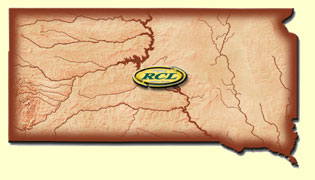RCL Tour preview: Lake Sharpe, April 30-May 3

Decisions, decisions: A no-cull tournament with the possibility of long runs faces the field in the second tournament of the year
PIERRE, S.D. – Stay or go? Jig or troll? Keep it or release it?
So go the vexing questions facing the Wal-Mart RCL Walleye Tour competitors on Lake Sharpe, where about 65 miles of Missouri River stretch between Oahe Dam, near Pierre, and Big Bend Dam, near Fort Thompson. In advance of Wednesday’s start of competition, every pro in the field will have to hatch a plan that takes into account whether to run more than 50 miles south in the attempt to find bigger fish, whether to jig small spots with precision or to cover water trolling, and whether to put keeper fish in the box or release them immediately in a no-cull tournament.
In accordance with state regulations on Sharpe, only two walleyes (or saugers) in a six-fish limit may be past the 18-inch mark. The minimum size limit for the tournament is 15 inches. All in all, in combination with the possibility of long runs when thunderstorms are forecast for Wednesday and Thursday, there’s a lot on the minds of the competitors in advance of the second tournament of the year for the second straight year on the Missouri River.
“There are not a lot of fish over 18 inches to choose from, and we’ve cycled through a lot of fish each day,” says Lund pro Todd Frank of Pulaski, N.Y. “You have to bring in six fish to be competitive. You can’t skip one fish here.”
Fishing memories?
So far during pre-fishing, the walleyes have been plentiful – no surprise on fish-filled Sharpe – though they are smaller than in 2002’s RCL tourney here, when 9 pounds a day put you well down in the standings. This time around, 9 pounds a day over the first two days might approach the top-20 cut. The bottom line? You’re going to have to go through a lot of walleyes and make the right decisions on which ones to bring to weigh-in when tenths, and perhaps hundredths, of ounces will come into play.
“The key to this tournament is being able to sort through fish to get the fatter ones,” says inveterate Lund pro Gary Roach of Merrifield, Minn. “You might get a 16-incher that weighs 1.1 pounds and another that weighs 1.5 pounds. You might get a 17-incher that weighs less.
“Everyone’s talking last year and fishing memories. I just go by what I see and what I’m catching. If I can get 40 fish, hopefully I can have a 20-incher or two.”
Several factors confounding anyone bent on memories of last year include a preponderance of male walleyes, which are slim fellas with scant weight, vs. a scarcity of heavier females. So, too, is the trend of many fish but few sizable ones coming within five miles of takeoff, where last year’s tournament was won. Also, water temperatures to the north are a cool 43 degrees, and it seems the walleyes are more active far from the launch site, where the temperatures are in excess of 50 degrees.
Which is why, to be competitive, you might have to be king of the road – er, water – and make a 100-mile roundtrip that could eat up four hours of fishing time. Then, with the no-cull in effect, there’s always the possibility of slipping a couple of 18 1/2-inchers in the box early in the day and having to release something bigger.
If early predictions are any indication, weights are going to be down from last year, but the same difficult decisions will have to be made.
“When we go to these no-cull tournaments, I try to break the double-digit barrier and catch at least 10 pounds,” says Cresliner pro Eric Naig of Cylinder, Iowa. “But it’s hard to know whether to keep a 17-incher early in the day when it’s scrawny.”
`Two weapons here’
In any spring river tourney, jigging and crankbait trolling will enter into the equation, as was evidenced in April’s RCL event on the Illinois River, where trollers and handliners excelled over the first two days and jigging expert John Kolinski of Menasha, Wis., took the tournament jigging during an increasingly difficult bite.
Here on the Missouri, the jigging is taking shape with a pair of patterns. One is to vertical jig with minnows in the swifter upstream current several miles below the dam. Another is to pitch jigs with minnows or plastic tails to the scenic, unpeopled and undeveloped bluffs and draws well downstream, where mule deer climb the slopes and wild turkeys gobble from the shoreline. On the other hand, trolling crankbaits on lead-core line is producing fish as well. But which technique will come up big?
We’ll have to wait and see if one or the other prevails. Then again, maybe the riddle will be solved with a combination of the two techniques.
“It’s going to be won cranking or jigging,” Frank says. “And you can take that to the bank. “But there are some areas that you troll. If you don’t get them there, though, you might run to another spot and jig them. You have to have two weapons here.”
Wednesday’s takeoff starts at 7 a.m. from Downs Marina in Pierre.